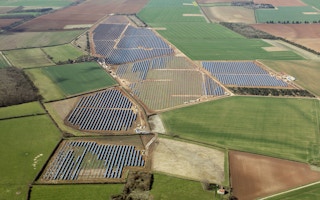As government officials meet in Paris this week to discuss ways to collectively cut global greenhouse emissions, the private sector has announced a slew of initiatives to boost adoption of renewable energy worldwide, a crucial element in achieving ambitious climate targets.
Adnan Z. Amin, director-general of International Renewable Energy Agency (Irena), said that renewable energy is rightly seen as “central” to the UN climate change talks, aimed at hashing out a universal deal to cap global temperature rises to under two degree Celsius.
Speaking at the opening of ‘Focus on Energy Day’, held at the sidelines of the UN talks in Paris, Amin said it is possible to double the current capacity of renewable energy by 2030, which will give the global community “half of the emissions reductions that we need”.
“If you put that together with energy efficiency (measures), this is probably the most economic, most efficient and politically feasible way to remain under the two degrees threshold,” he added.
In order to achieve that target, the world needs to vastly increase its investment in clean energy. Annual investment in renewables is currently at US$280 billion, Amin said, and Irena estimates that the figure needs to jump to about US$500 billion by 2020.
Between 2021 and 2030, the number will need to further rise to US$900 billion a year.
To give the sector a boost, Irena is spearheading three initiatives. The first is the expansion of the Small Island Developing States–Lighthouses project, launched in 2014 to help small island states adopt renewable power.
Since the programme was established in May last year, 29 small states have joined, 18 of which have developed roadmaps for deployment of clean energy in their countries.
Small-island states are particularly vulnerable to the effects of climate change as they are low-lying and would be the first to be submerged if sea levels rise to dangerous levels.
Close to US$250 billion of investments have already been either earmarked or committed by governments and private companies globally, and close to 20 to 25 megawatt of projects have been deployed.
Amin said he would like more companies to get involved, either as project experts or financiers.
The second initiative is the Sustainable Energy Marketplace, an online “match-making” platform for renewable energy projects, investors, developers and technology companies to make connections. The Marketplace has started with projects in Africa and small island states.
Amin expects that by the end of 2016, the platform should have 100 energy projects. Over the next three years, it is forecasted to raise US$10 billion.
IRENA is also launching the Global Geothermal Alliance, aimed at raising the use of geothermal power around the world.
“To achieve our joint targets, we need to use all sources of renewable energy,” Amin said. “Currently, we have geothermal potential in more than 90 countries around the world but 90 per cent of that is untapped. We have installed only 12 gigawatt currently.”
The Global Geothermal Alliance aims to achieve a 500 per cent growth in installed capacity for geothermal power generation and a 200 per cent increase in geothermal power heating by 2030.
The Alliance, first proposed a year ago, now has 36 member countries and 23 institutions.
Private funding, public resources
Khaled Fahmy, Minister of the Environment, Egypt, announced the Africa Renewable Energy Initiative (AREI), a private-public partnership aimed at building at least 10 gigawatt of renewable energy generation capacity by 2020 and 300 gigawatt by 2020.
Currently, only32 per cent of Africa’s population has access to electricity. The AREI will aim to increase that to 72 per cent by 2030.
Other projects that were announced during ‘Focus on Energy’ are:
- ElectriFi, a new public-private fund with an initial 75 million euros from the European Commission;
- Some 775 companies, more than 130 national, regional and local governments and over 100 financial institutions commit to ramping up energy efficiency measures and investments under the Sustainable Energy for All (SE4All) initiative’s ‘100/100/100’ campaign;
- Through the En.Lighten and Clean Energy Ministerial Global Lighting Challenge, more than 70 countries agree to phase out incandescent bulbs and promote the most efficient lighting technologies such as LED. Lighting consumes 15 per cent of all electricity generated and accounts for 5 per cent of all greenhouse gases.
- More than 60 countries are joining Global Fuel Economy Initiative (GFEI) to implement public policies for vehicle energy efficiency aimed at halving average energy consumption by 2050.
- Two large scale pilots will be launched in China and India through the Industrial Energy Efficiency Accelerator that will result in concrete emission reductions from the industry sector during 2016-2020.
- More than 100 banks and investors, managing close to US$ 4 trillion in assets, have committed to lending more money to energy efficiency projects. Led by the European Bank for Reconstruction and Development and UNEP Finance Initiative, this is a major undertaking by financial institutions globally.
Rachel Kyte, chief executive of Sustainable Energy for All (SE4All), a World Bank-United Nations partnership, said that the initatives by the private sector and the setting up of several public-private partnerships were an “encouraging” sign. They should go a long way in helping the world shift to a low-carbon economy, she noted.
“You can see everything here in a material way, with real conversations and real money being put on the table,” Kyte said. “That’s what different about this COP from the others than I have seen.”





















